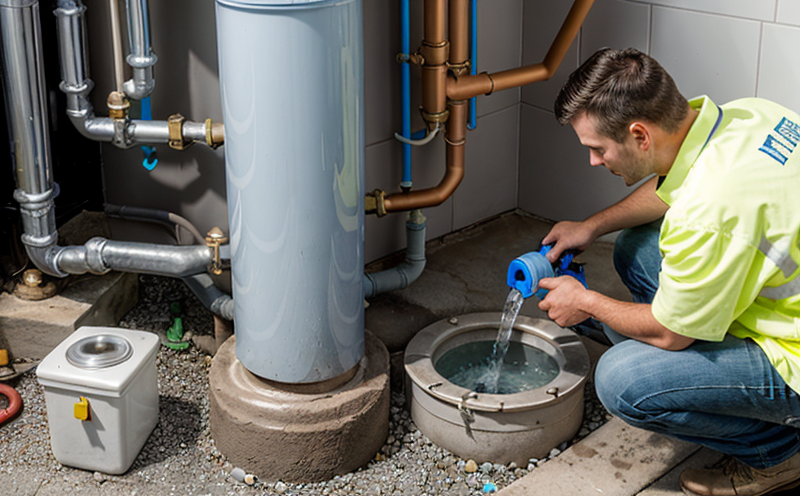ASTM F2389 Testing of PEX Pipes
The ASTM F2389 standard is a critical document in the testing and certification of cross-linked polyethylene (PEX) pipes. This service ensures that PEX piping systems meet the stringent performance requirements necessary for reliable plumbing and water supply applications.
ASTM F2389 defines procedures to test the pressure resistance, burst strength, and other mechanical properties of PEX pipes under various conditions. This testing is essential in ensuring the safety and durability of plumbing systems used in residential and commercial buildings. The service provided encompasses a comprehensive suite of tests designed to meet these standards.
PEX piping has gained significant popularity due to its flexibility, resistance to high temperatures, and ease of installation. However, it is crucial that these pipes are rigorously tested to ensure they can withstand the pressures and conditions they will face in real-world applications. This service offers an array of tests that address various aspects of PEX pipe performance.
The testing process begins with careful preparation of the specimens according to ASTM F2389 guidelines. The pipes are subjected to a series of mechanical and hydraulic tests under controlled conditions. These tests include pressure resistance, burst strength, and elongation at break. Each test provides specific insights into the pipe's performance and durability.
During the pressure resistance test, specimens are exposed to increasing hydrostatic pressures until they either fail or reach a specified duration without failure. The burst strength test involves applying incremental pressure beyond the expected operating range of the piping system until failure occurs. This helps in determining the maximum load-bearing capacity of the PEX pipe.
The elongation at break measurement assesses how much the pipe can stretch before breaking, which is crucial for understanding its flexibility and potential to withstand thermal stress. These tests are conducted using specialized equipment that ensures accurate and repeatable results.
Once the specimens have undergone these mechanical and hydraulic tests, they are analyzed in detail. The data collected from each test is carefully recorded and compared against the standards outlined in ASTM F2389. This allows for an objective evaluation of the pipe's compliance with the required specifications.
| Standard | Description |
|---|---|
| ASTM F2389-19 | Procedure for the pressure resistance, burst strength, and elongation at break testing of cross-linked polyethylene (PEX) piping systems. |
Why It Matters
The importance of ASTM F2389 Testing cannot be overstated, especially in the context of building and infrastructure testing. Ensuring that PEX piping systems meet these stringent standards is crucial for several reasons:
- Enhanced Safety: Properly tested PEX pipes reduce the risk of leaks, bursts, or other failures that could lead to water damage and potential hazards.
- Durability: Testing ensures that the pipes can withstand the pressures and temperatures they will encounter in real-world applications, extending their lifespan significantly.
- Regulatory Compliance: Meeting ASTM F2389 standards helps facilities comply with local and international regulations, ensuring long-term operational reliability.
- Customer Trust: Reliable plumbing systems built using tested PEX pipes enhance the reputation of the facility or construction project.
In summary, ASTM F2389 Testing is vital for maintaining high standards in plumbing and water supply systems, ensuring they are safe, reliable, and compliant with industry best practices.
Applied Standards
| Standard | Description |
|---|---|
| ASTM F2389-19 | Procedure for the pressure resistance, burst strength, and elongation at break testing of cross-linked polyethylene (PEX) piping systems. |
Quality and Reliability Assurance
The quality and reliability assurance processes for ASTM F2389 Testing are designed to ensure that every test conducted meets the highest standards of accuracy and consistency. This involves several key components:
- Calibration of Equipment: All testing equipment is regularly calibrated to ensure precise measurements.
- Standard Operating Procedures (SOPs): SOPs are strictly followed to maintain uniformity and repeatability in test results.
- Training of Personnel: Only trained personnel conduct the tests, ensuring that each step is performed correctly.
- Data Verification: Data from each test is cross-verified for accuracy before being documented.
The rigorous quality assurance measures ensure that every PEX pipe tested meets or exceeds the requirements set forth in ASTM F2389. This not only enhances the reliability of the testing process but also builds confidence among stakeholders, including architects, engineers, and building owners.





